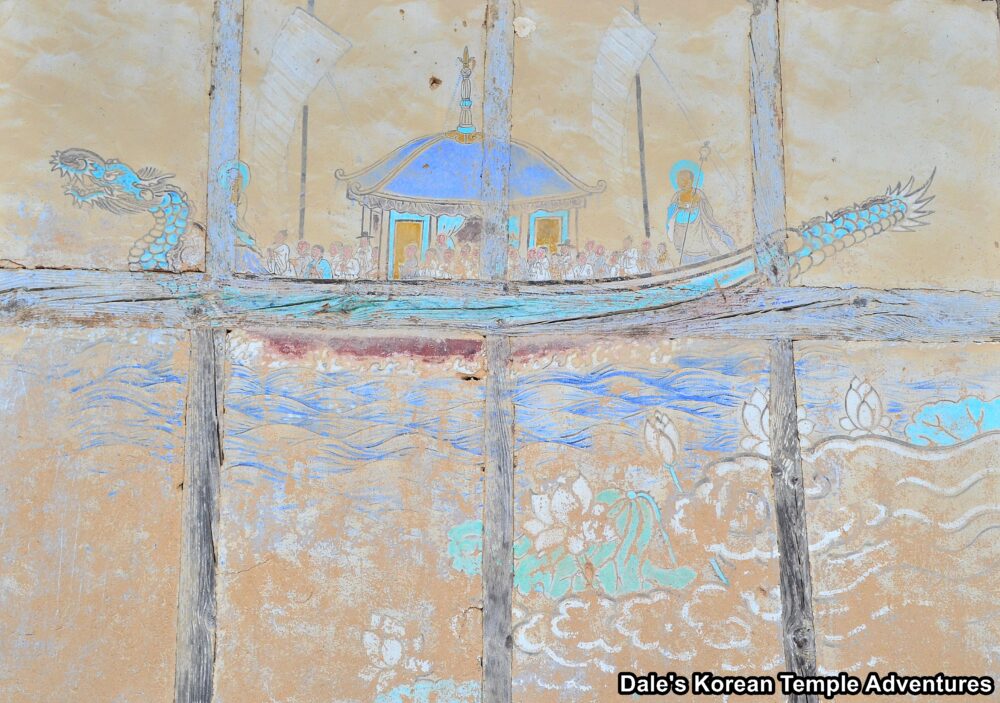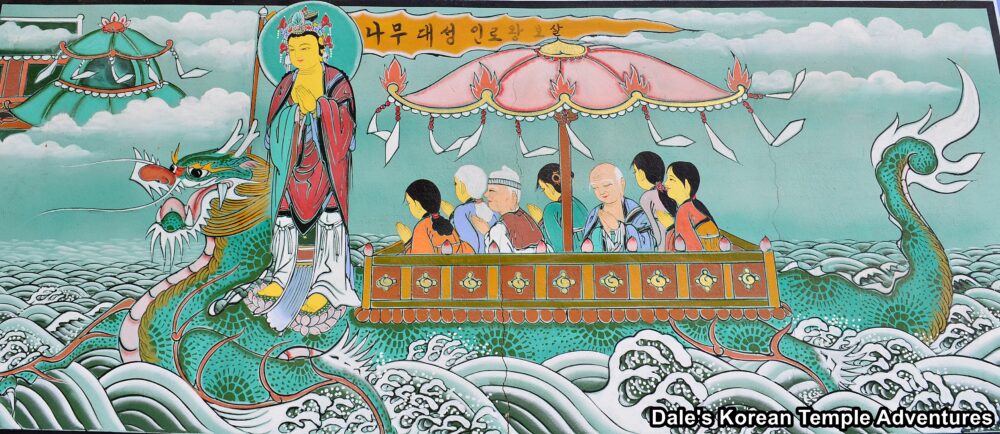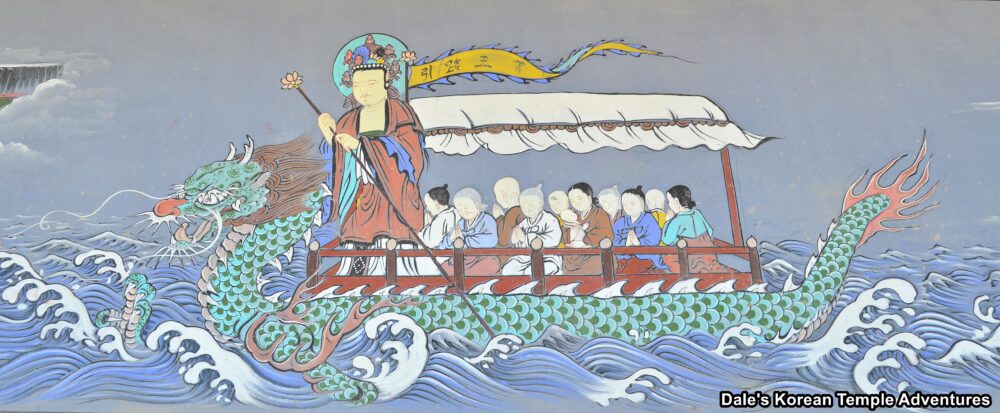Banya Yongseon-do – The Dragon Ship of Wisdom: 반야 용선도

The Purpose of the Dragon Ship of Wisdom
One of the more distinctive paintings that you’ll find at a Korean Buddhist temple is the Banya Yongseon-do, or “The Dragon Ship of Wisdom Mural” in English. In this painting, you’ll see a dragon-shaped boat with passengers on it and a pair of Bodhisattvas looking like they’re the captain of this symbolic ship. So what exactly is this painting meant to symbolize? How does it relate to Korean Buddhism? And who exactly are the two Bodhisattvas and passengers onboard this ship?
The purpose of the Dragon Ship of Wisdom is to help ferry devotees of Buddhism across Samsara (the endless cycle of rebirth, existence, and death) to the Pure Land, or “Jeongto” in Korean. In Korean, Samsara is known as Yunhwi. Yunhwi literally means “continuous flowing.” And it’s across the Ocean of Suffering, Samsara, that the Dragon Ship of Wisdom sails across to arrive on the other shore where Jeongto, the Pure Land, is situated.


The Dragon Ship of Wisdom Design
The Dragon Ship of Wisdom, rather expectantly, is designed like a dragon. The bow of the ship has a dragon’s head, while the stern is designed as a dragon’s tail. Usually, the Dragon Ship of Wisdom is painted blue with a collection of Buddhist devotees as occupants. Typically, you’ll find two Bodhisattvas riding the Dragon Ship of Wisdom, as well. One of these Bodhisattvas is Gwanseeum-bosal (The Bodhisattva of Compassion). And the other is Jijang-bosal (The Bodhisattva of the Afterlife), who is also known as the “Earth Womb Bodhisattva.” The reason that you’ll find Jijang-bosal on the Dragon Ship is because this Bodhisattva is devoted to saving all sentient beings in the Six Realms of existence. As for Gwanseeum-bosal, the reason that you’ll find her on the Dragon Ship of Wisdom is that she takes care of all the complaints of the world. Sometimes, you’ll see Gwanseeum-bosal standing on the dragon as it sails across Samsara. Sometimes you’ll even see Yongwang (The Dragon King) accompanying Gwanseeum-bosal as her attendant. In this case, Yongwang is helping the Dragon Ship of Wisdom cross Samsara.

Where to Find the Dragon Ship of Wisdom at a Korean Buddhist Temple
Typically, you’ll find the Dragon Ship of Wisdom mural in one of two places at a Korean Buddhist temple, both of which, are temple shrine halls. The first temple shrine hall that you can find this mural, either inside or outside the temple structure, is the Geukrak-jeon Hall. The Geukrak-jeon Hall is dedicated to Amita-bul (The Buddha of the Western Paradise), which is a rather obvious reason as to why you’ll find the mural in this location. And the other temple shrine hall that you can find the Dragon Ship of Wisdom mural is, once again, adorning the exterior or interior walls of another temple shrine hall; this time, the Myeongbu-jeon Hall. This temple shrine hall is dedicated to one of the two occupants of the Dragon Ship, Jijang-bosal (The Bodhisattva of the Afterlife).
More symbolically, and not in mural form, each temple shrine hall is in fact meant to embody the Dragon Ship of Wisdom. Typically, you’ll find dragon heads carved near the entry of a Korean temple shrine hall. The body of these dragons run inside and across the shrine hall. Additionally, you’ll find that the interiors have either paintings or carvings of dragons. In this case, the dragon design of the temple shrine hall is meant to symbolize the Dragon Ship of Wisdom. Each temple shrine hall is symbolically carrying humans from the shore of earthly existence, across Samsara (Yunhwi), to the Pure Land (Jeongto). So as a whole, each and every temple shrine hall at a Korean Buddhist temple is a vehicle that aids devotees towards the Pure Land.

Examples
There are quite a few beautiful examples of the Dragon Ship of Wisdom throughout the Korean peninsula, so here are just a few. Perhaps the most masterful is the one that adorns the back exterior wall of the Geukrak-jeon Hall at Tongdosa Temple in Yangsan, Gyeongsangnam-do. With its fading pastel colours, you can see this wonderful mural as you first enter the lower courtyard at the temple. Another great example can be found at Unmunsa Temple in Cheongdo, Gyeongsangbuk-do with the solitary image of Gwanseeum-bosal guiding the dead across Samsara. Other great examples of the Dragon Ship of Wisdom can be found at Pyochungsa Temple in Miryang, Gyeongsangnam-do; Haegwangsa Temple in Gijang-gun, Busan; and Buseoksa Temple in Yeongju, Gyeongsangbuk-do.
Conclusion
So the next time you’re at a Korean Buddhist temple, have a good look around for the dragons. If you’re lucky enough, you’ll be able to see a ship designed like a dragon. And now you’ll know that this ship, the Dragon Ship of Wisdom, is transporting the souls of the dead across Yunhwi (Samsara) to Jeongto (the Pure Land).
